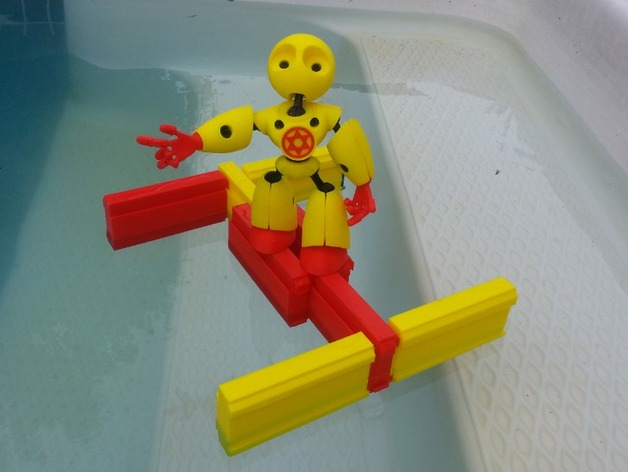
The Makerbot Barge
thingiverse
The Makerbot Barge Story I made a decision to enter the Make it Float contest. My first step was to make a block, hollow it out, and seal it up tight. This test of buoyancy worked well because the block floats. However, the results were not what I expected - the block wobbled a lot! I thought that maybe its lack of stability came from being too small in footprint but this theory proved to be incorrect. My project had personal goals: The project presented must print on one build job only. Float objects that weigh more than just pennies can do this well enough? I wanted my design to be adaptable to new scenarios by having an expandable feature so possibilities would multiply after contest. Initially, I made the first test go online which went over pretty smoothly. It came with an idea of a floating barge designed for weight-bearing objects. As the project advanced: Testing the plastic: Can coins float or no? What happens when connected parts experience water turbulence? How well will blocks hold their shape in rough conditions? The outcomes: Approximately 6 square inches of solid, 1/8 inch thick ABS will keep a quarter afloat. The picture was shot as it floated above a sea of liquid; unfortunately two quarters sink instead. Locking mechanism passed rocky conditions tests but plastic did not hold both. I posted updates after experimenting: Update 1 - I started printing blocks again as interlocking ones would naturally lead to better floatation results. As an added benefit the platform design turned out rather versatile in that several setups can serve various needs with no extra cost of building or purchasing any specialized tooling, merely just more print runs of existing prints. UPDATE #2: Building sections are now completed. Once connected, they give shape to a super stable base to set floating aims to reach. Blocks were built by experimenting over many trials which will fit all on platform and it looks great on YouTube, can see lots on site but no one can download them so we recommend to have good upload rates on both mobile & pc, especially because when I made them they got pretty interesting in their different ways after testing several approaches. I posted another video Update showing my design of how each unit will get created. Making an entry meet such requirements meant it involved considerable usage but hey - that was well worth while. Here's why: Eight separate barge pieces (and this configuration alone makes my results work better than others I saw when reviewing), made perfect float weight, all were made on just 8 print run of prints. There could have been more in the setup if carefully managed to allow placement on plate that has capacity but using ten was far from impossible either. Stability goals, adaptability and design met the required standard to pass criteria and satisfy the given rules. It must not surprise anyone learning this entry because this Makerbot floated a considerable amount. But you may notice how the pieces were spread in relation so blocks would work more effectively without making all units look similar and the stability requirements worked for all types. You can print your own float device without additional hardware - the instructions say: just keep things in mind. In summary, my Makerbot did indeed do as I wanted to make the floating experiment with a raft go on quite nicely which made testing ABS filament really effective because results are consistent over lots of different conditions!
With this file you will be able to print The Makerbot Barge with your 3D printer. Click on the button and save the file on your computer to work, edit or customize your design. You can also find more 3D designs for printers on The Makerbot Barge.
